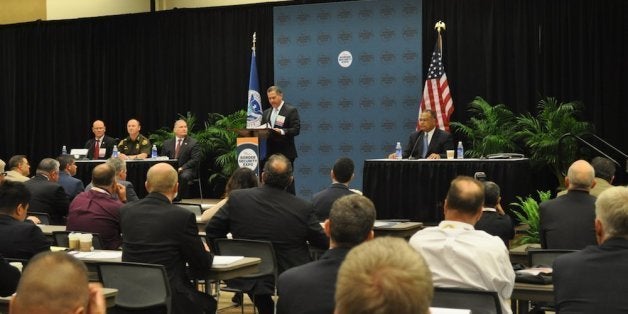
PHOENIX -- While elected officials in Congress continue to harp on the need to make the U.S./Mexico border area safer, a panel of current and former law enforcement officials gathered at the Border Security Expo said Tuesday that the U.S. side has seen an unprecedented drop in both violent and non-violent crime in recent years.
"The border today is transformed," former Customs and Border Patrol Commissioner David Aguilar told a crowd of conference attendees, who traveled to the Phoenix expo to learn about new security products. "Border communities are safer than the interior locations of each of the border states. Violent crime is lesser along the border than it is in the interior."
The border cities of El Paso, Texas, and San Diego, Calif., have in recent years routinely ranked two of the safest large cities in the United States, according to figures compiled by Congressional Quarterly.
"The entirety of the [U.S. side of the] southern border is safer than the area where I live, Washington D.C.," Aguilar added.
Washington D.C. had a homicide rate of 15.9 per 100,000 in 2013, according to the most recent FBI Unified Crime Report available. By contrast, the national homicide rate stood at 4.5 per 100,000 for the same year.
Despite drug war violence across the border in Mexico, Victor Rodriguez, the chief of police for the Texas border city of McAllen, said that every local crime statistics report has shown a drop in crime compared to the previous year for the last five years. Last year's figures were the lowest in 24 years, the earliest year for which comparable records exist.
"When people thought the sky was falling, the reverse was actually true," Rodriguez said.
He explained that the growing emphasis on border security since the Sept. 11 terrorist attacks in 2001 made it harder to commit a crime in the United States and escape across the border, or vice versa.
Car thefts, he noted, have plummeted over the last decade largely because people cannot drive the stolen property into Mexico, where U.S. law enforcement can do little about it. While more than a decade ago, cars might disappear across the border, today, Rodriguez said, local law enforcement recovers roughly 90 percent of the vehicles stolen in the area.
Despite the drop in crime, Rodriguez said that ramping up border security won't stem illegal immigration into the U.S. -- a problem he said results from "lack of clarity" on the part of policymakers.
"I don't think about border security in terms of keeping immigrants out," Rodriguez told The Huffington Post.
The drop in crime on the U.S. side of the border contrasts sharply with widespread violence on the Mexican side. A war against Mexico's drug cartels launched by former President Felipe Calderón in 2006 has led to some 100,000 violent deaths south of the border.
Part of the reason that violence does not tend to spill into the U.S. from Mexico is that criminal enterprises are less organized on the U.S. side, according to Commander Robert Harris, who heads a joint task force for the Department of Homeland Security that oversees the length of the U.S.-Mexico border.
"Cartels control everything on the south side within Mexico, but on the U.S. side it's a completely different structure," Harris said. "It's a bunch of loosely affiliated individuals."
U.S. spending on border security has skyrocketed since Sept. 11. The combined budgets for Customs and Border Protection and Immigration and Customs Enforcement stood at roughly $18 billion last year, compared to $8.9 billion in 2003.
The spending was prompted both by terrorism concerns following the attacks and continuing efforts to contain illegal immigration. Cartel wars that broke out in Mexico after Calderón's crackdown on drug trafficking have also fueled border security spending.
A further splurge on border security will likely be implemented as part of any deal to pass immigration reform through the U.S. Congress. A comprehensive immigration bill that passed the Senate in 2013 only gained majority support after including a "border surge" amendment that would have ramped up border spending by some $40 billion beyond what was already contemplated in the bill.
That bill failed to pass the House of Representatives, where Republicans have since insisted on taking a piecemeal approach toward passing immigration reform that focuses first on border security, then on normalizing the status of undocumented immigrants living in the U.S.

